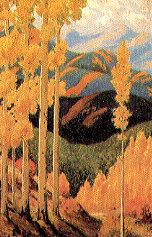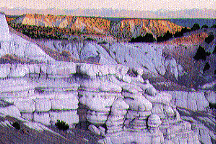John Marin, probably the most important American artist to work in watercolor, came to Taos for a brief time and left his mark on artists such as Victor Higgins. In Santa Fe, Robert Henri and John Sloan were important influences on the art colony, Henri for just two years, and Sloan for almost thirty summers. Undoubtedly, the single most important artist to move to New Mexico was Georgia O'Keeffe whose magnificent paintings of New Mexico stand as one of the most significant achievements in American Art.
Historically, landscape is one of the three great subjects in art, the others being still-life, and representations of human beings. For many centuries landscape played a minor role in European painting, appearing primarily as a background in portraits and religious works. In oriental art, landscape was an important subject much earlier than in the West. It is only in the last few centuries that landscape has come into its own in countries such as England, with the painting of Gainsborough and his followers, and in France with the Barbizon painters who shocked their peers by going into the country to paint on site. Landscape painting has never had greater emphasis than in the work of the Impressionists who reveled in the land and attempted to catch the atmospheric effects of weather and light as had no other painters before them.
It is important to recognize that all artists are influenced and inspired by the works of those who come before them, but the great ones find their own unique style, often blending or borrowing from the work of artists they admire. Metaphorically, it has been said that art is not a hundred-yard dash, but rather a relay in which one accepts the baton from behind, carries it forward, and passes it to the next generation.
The quality of work currently being produced in New Mexico is extremely high. It is immediately apparent that the major styles of our century have influenced painters in New Mexico and have been adapted by them to create unique ways of recording the landscape. Impressionism, Expressionism, Fauvism, Cubism, Surrealism, Art Deco, Abstract Expressionism, to name a few, have all been part of the vocabulary of artists working in New Mexico. An analogy might be to consider the popular music of this century, which has been unendingly innovative, often shocking, but ever creative.
In New Mexico, the land remains as challenging and inspirational as it was a hundred years ago, and I would hope that a hundred years from now artists will still be creating paintings to celebrate their love for this incredible corner of planet Earth. Writing of his first impressions of New Mexico, D. H. Lawrence said: "The moment I saw the brilliant, proud morning shine high up over Santa Fe, something stood still in my soul, and I started to attend. . . In the magnificent fierce morning of New Mexico one sprang awake, a new part of the soul woke up suddenly, and the old world gave way to a new." (D. H. Lawrence, "New Mexico," in Survey Graphics, May, 1931, reprinted in Phoenix: The Posthumous Papers of D. H. Lawrence, pp 141–47) |


